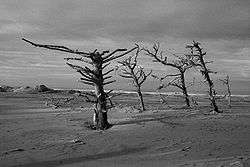Lanphere Dunes
The Lanphere Dunes, a unit of the Humboldt Bay National Wildlife Refuge Complex, is located in Humboldt County, California. The dune complex consists of the wave slope, fore dune, herbaceous and woody swales, coniferous and riparian forest, freshwater swamp, freshwater marsh, brackish marsh, salt marsh, and intertidal mudflats. The site exemplifies dunes succession and as a fragile ecosystem, access is restricted and guided tours are available. It has been said that because of the very little human contact that is received near and on the Lanphere dunes themselves, the environment there is left in an almost "primordial" state.[1]

History
The area was historically occupied by Wiyot prior to European settlement when, in the 1930s, William and Hortense Lanphere made it their home. For the next 40 years they maintained the dunes in a relatively pristine state. In 1975 a movement for permanent protection was made by the Lanpheres and faculty from Humboldt State University who used the area for botany classes. Working with The Nature Conservancy the area was protected and turned over to the National Wildlife Refuge System for management.[2] Site management focuses on the prevention and eradication of invasive plants and the restoration of dune and estuarine processes.[3] The Fish and Wildlife agency that works here maintains the Lanphere dunes in a very minimalist way, only removing any invasive species that encroach upon the dunes.
Flora and fauna
Flora
Due to its isolation, Lanphere Dunes is home to many uncommon and geographically displaced flora including two federally listed species found in this habitat: Humboldt Bay wallflower (Erysimum menziesii subsp. menziesii) and beach layia (Layia carnosa). Other rare and endangered plants include Pink sand-verbena (Abronia umbellata subsp.brevifolia), Humboldt Bay owl's clover (Castilleja ambigua subsp. humboldtiensis), Point Reyes bird’s-beak (Cordylanthus maritimus subsp. palustris), dark-eyed gilia (Gilia millefoliata), American glehnia (Glehnia littoralis subsp. leiocarpa), western sand spurrey (Spergularia canadensis subsp. occidentalis) and the sea-watch (Angelica lucida). Other species of plants include Kinnikinnick (Arcotstaphylos uva-ursi) and reindeer lichen (Cladonia rangiferina).
Many of the lichens and flora that still thrive in the Lanphere Dunes are from an epoch that passed long ago, with reindeer lichens thriving well after the Ice Age. Varieties of flora often found in Lanphere Dunes that are typically common are often far away from their natural ranges.[4] Sands that are blown in with the occasional ocean breezes remain trapped in the forests, killing off the trees and leaving behind "skeleton forests," areas where all the husks of former trees are plentiful. American Dunegrass (Leymus mollis) used to be plentiful, once found along the west coast as south as Morro Bay in California, this native grass now occurs in just two areas along the California coast, Point Reyes and the Lanphere Dunes.[5] European Beachgrass is an invasive species that was found to be omnipresent in the Lanphere Dunes, having taken over many of the areas formally occupied by native grasses. Between 1992 and 1997, European Beachgrass from the dune zone was manually removed by laborers from the California Conservation Corps funded by the Nature Conservancy.[6] After starting the restoration project in 1992, native plant cover in Lanphere Dunes increased by 47% by the year 1997 without the assistance of active re-planting.[5]
Native species of dunes grass that have experienced a comeback in population count are American dunegrass, silver bursage, beach morning glory (Convolvulus soldanella), and dune tansy also referred to as (Tanacetum douglasii).[7] Together, all these dune grasses form the fore dune's ecosystem that used to be extensive along the coast before the spread of invasive species.[7]
Fauna
The fauna in Lanphere Dunes occupy the many ecological niches that Lanphere Dunes provides.[8] Lanphere Dunes provides shelter and forage for larger animals including black-tailed deer, bobcat, mountain lion, grey fox and porcupine. Smaller mammals that live in Lanphere Dunes include the dusky-footed woodrat, white-footed deer mouse, Pacific jumping mouse, California harvest mouse, Trowbridge shrew, Vagrant shrews, shrew moles, California voles, and the rare white-footed vole. Botta’s pocket gopher (Homomys bottae aticeps) is very prominent on the surfaces of the dunes, due to the species' large population in Lanphere Dunes.[8] Due to their adaptability, coyote, gray fox, Virginia opossum and raccoon can be found in a wide variety of the refuge habitats.[8]
See also
References
- Michael Kauffman (2014).
- John O. Sawyer (2006). Northwest California: A Natural History. University of California Press. ISBN 978-0-520-92836-7.
- Andrea J. Pickart; John O. Sawyer; California Native Plant Society (1 December 1998). Ecology and restoration of Northern California coastal dunes. California Native Plant Society. ISBN 978-0-943460-38-3.
- Kauffmann, Michael. Lanphere dunes ~ Humboldt Bay National Wildlife Refuge.
- Martin, Tunyalee. "A Success Story Lanphere Dunes Unit, Northern California" (PDF). The Nature Conservancy. Retrieved 12 December 2014.
- Andrea Pickart, Lanphere Dunes Restoration Photodocumentation (2014)
- Kanwischer, Derek H. "The Geography of Invasive Plant Species on the Coastal Dunes: Northern California". self. Retrieved 12 December 2014.
Unpublished thesis Montana State University 5-03-2003
- Humboldt National Wildlife Refuge - Mammals